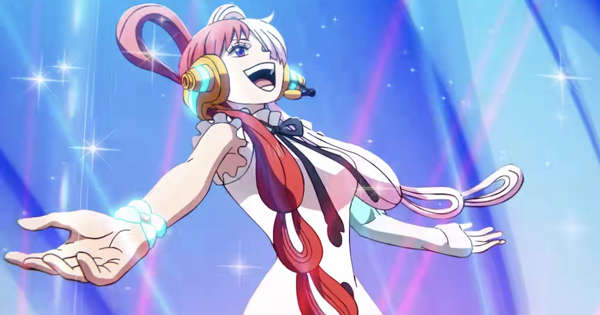
Just how far can Luffy stretch? That’s a question “One Piece” fans have been asking for years of the Gum-Gum hero with the go-go-gadget arms. Sure, there are limits to Luffy’s flexibility, but if you look at the pirate adventure series to which he belongs — one that’s been serialized for 25 years running, generating more than 100 books, 1,000-plus anime episodes and 15 theatrical features — it would seem that “One Piece” creator Eiichiro Oda can stretch the entire franchise pretty much as far as he pleases.
Case in point: The series’ latest entry, “One Piece Film: Red,” expands into musical territory, focusing on a pop star named Uta who has been made powerful by the Sing-Sing Fruit. “One Piece” characters gain special abilities after consuming Devil Fruit (Gum-Gum is Luffy’s), and Sing-Sing skills allow this chic chanteuse with two-tone hair and a worldwide fan base to whisk listeners into a kind of parallel dimension she calls “New Genesis.” At first, this would seem to be a good thing: Uta loathes war and wants to make “a better world with none of the cruelty and violence.” But like Ultron in the “Avengers” movies, her plan to alleviate suffering would come at an enormous cost.
Available either dubbed or subbed in the U.S. courtesy of Crunchyroll, this blockbuster toon (already the sixth-highest-grossing Japanese film of all time in its home country) opens with one of Uta’s concerts. The daughter of Shanks — one of “One Piece’s” most famous pirates — Uta grew up practically alone on Elegia, the island of music, building a massive following from her remote home thanks to a special “One Piece” technology: video transponder snails. Her identity and past have been a mystery until now. No sooner has her opening song ended than Luffy swings down onto the stage to reveal a personal connection to this character.
As it turns out, Luffy and Uta were childhood friends (Shanks is the same pirate who gave Luffy his signature straw hat), and the long-limbed kid might be the only person on Earth who can talk Uta out of her dangerous plan: Basically, she promises that her anti-war concert will go on forever, not telling all those who attend that they risk being permanently trapped in her alternate reality.
Much of the film is dedicated to Uta performing her most popular songs (Ado supplies the vocals), which the dubbed version doesn’t translate. Subtitles convey the lyrics, but the tunes still sound too bland to have launched such a phenomenon. That’s a different strategy from Mamoru Hosoda’s far better “Belle,” for which GKIDS took the trouble to produce a terrific English-language soundtrack; ”Belle” also did more with viral sensations and virtual worlds in the narrative itself.
For all its pleasures, the “One Piece” TV series is known for its subpar-to-awful animation (spend some time on fan forums, and that complaint arises all that time). The team at Toei have significantly improved the quality for the feature, but no one expects first-rate visuals. The “Red” soundtrack falls in the same good-enough-to-better-than-you’d-expect zone. The fun here comes from surprising audiences with emotionally grounded plot twists and deep-cut cameos from characters like Mini Bepo and Rob Lucci (a villain whose motives echo Uta’s) — and of course, Shanks’ return, to face his adopted daughter.
Devil Fruits give powers but also take something away, and performing proves super-exhausting to Uta, who keeps herself going by gobbling Wake-shrooms between sets, knowing that this crutch will eventually kill her. But if she realizes this, then her plan can’t work as advertised. It means the world’s No. 1 sweetheart — and self-proclaimed “savior of the downtrodden” — can’t go on singing forever, as she supposedly intends. Add in the movie’s parallel realities, and things get awfully complicated, especially the fight scenes.
The battles between pirates, Marines and Uta’s purple-cloaked personal guards are every bit as spectacular as one might hope, if more than a little difficult to follow. With the action split between Elegia and New Genesis, what happens if someone dies in either of these worlds? Can listeners who change their minds leave Uta’s trance? And what does the Demon Lord known as “Tot Musica” have to do with everything?
Safe to say that director Goro Taniguchi and screenwriter Tsutomu Kuroiwa aren’t afraid of confusing audiences and seem to have very little interest in accommodating first-time viewers, who will have a tough time orienting themselves to the extensive “One Piece” universe of characters. For the faithful, however, Uta proves an exciting new personality — an influencer extraordinaire and powerful rival to the pirates — who serves to bring back Shanks and his Red Hair gang while steering Luffy and his crew on a new course.
For more stories like this, follow us on MSN by clicking the button at the top of this page.
Click here to read the full article.